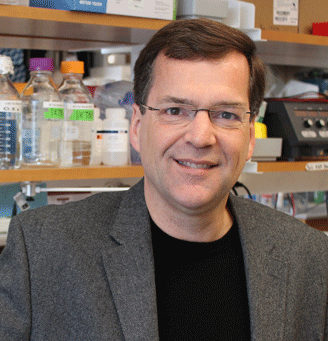 |
|
|
Erik Sontheimer, PhD |
CRISPR/Cas9 genome editing is quickly revolutionizing biomedical research, but the new technology is not yet exact. The technique can inadvertently make excessive or unwanted changes in the genome and create off-target mutations, limiting safety and efficacy in therapeutic applications.
Now, researchers at UMass Medical School and the University of Toronto have discovered the first known “off-switches” for CRISPR/Cas9 activity, providing much greater control over the edits, according to a new study published in Cell.
Erik J. Sontheimer, PhD, professor in the RNA Therapeutics Institute at UMass Medical School, and Alan Davidson, PhD, professor of molecular genetics, and Karen Maxwell, PhD, assistant professor of biochemistry, at the University of Toronto, identified three naturally-occurring proteins that inhibit the Cas9 enzyme. These proteins, known as anti-CRISPRs, have the ability to block DNA cleavage by the Cas9 nuclease.
“CRISPR/Cas9 is a good thing because it introduces specific chromosome breaks that can be exploited to create genome edits, but because chromosome breakage can be hazardous, it is possible to have too much of a good thing, or to have it go on for too long,” Dr. Sontheimer said. “There is a current shortage of reliable ways to turn off Cas9 once it has already been delivered to a cell. If you can trip an off-switch after the correct editing is done, then the problem is relieved. We report the first known natural inhibitors of Cas9 activity.”
“CRISPR is very powerful, but we have to be able to turn it off,” Dr. Davidson said. “This is a very fundamental addition to the toolbox, which should give researchers more confidence to use gene editing.”
The CRISPR/Cas9 system is an adaptive immune system used by bacteria to defend itself against foreign genetic material. It consists of two components: a molecular scalpel (Cas9) that cuts DNA efficiently but is muzzled in its native state, and an RNA guide complex that unlocks the scalpel when a matching genetic sequence, defining the exact spot to cut, is found. These RNA guides are produced from “clustered regularly interspaced short palindromic repeats” or CRISPR arrays, which contain remnants of the genomes of past viral infections. By arming the Cas9 nuclease to target and inactivate these viruses, the CRISPR/Cas9 system provides an adaptive immune defense for the bacterial cells.
Scientists can reprogram the CRISPR/Cas9 system with artificial guide RNAs to cleave sequences within mammalian genomes and enable the precise insertion of new fragments of genetic information into cells. A simple and efficient way of editing the genome, CRISPR/Cas9 is changing biomedical research by making it far easier to inactivate or edit genes in a cell line for study. It also simplifies creation of animal disease models that can be used to study human ailments. Work that used to take months or years to perform can now be done in weeks.
Despite the power of the CRISPR/Cas9 system, it isn’t exact. There are times when the RNA guide used to maneuver the cleaving enzyme into the right position within the genome also targets the enzyme to other sequences that are similar but not identical. These mismatched sites, which can occur as many as 100 times across the 6 billion nucleotides that make up the human genome, can sometimes also be cleaved, causing unintended damage.
In many CRISPR/Cas9 applications—including those under therapeutic development—there is a specific cell type, tissue or organ that is being targeted for editing, since that is where the disease manifests itself, or where the therapeutic benefit can be realized.
“CRISPR/Cas9 might go to the intended cells in these cases, but it will also likely go to other ancillary cells, tissues or organs as well. Cas9 activity in these ancillary cells, tissues or organs is at best useless and at worst a safety risk,” Sontheimer said. “But if you could build an off-switch that keeps Cas9 inactive everywhere except the intended target tissue, then the tissue specificity will be improved.”
The new paper not only identifies that “off-switch,” Sontheimer said, but it shows that Cas9 inhibitors exist naturally and can be identified and exploited.
“There are many different forms of Cas9 that are produced by different bacteria, and the different Cas9s can each have different useful properties in genome editing,” he said. “So there are already several Cas9s in the toolbox, with many more to come. We’ve now proven that such inhibitors are out there in the natural world and we’ve provided one possible strategy to find them.”